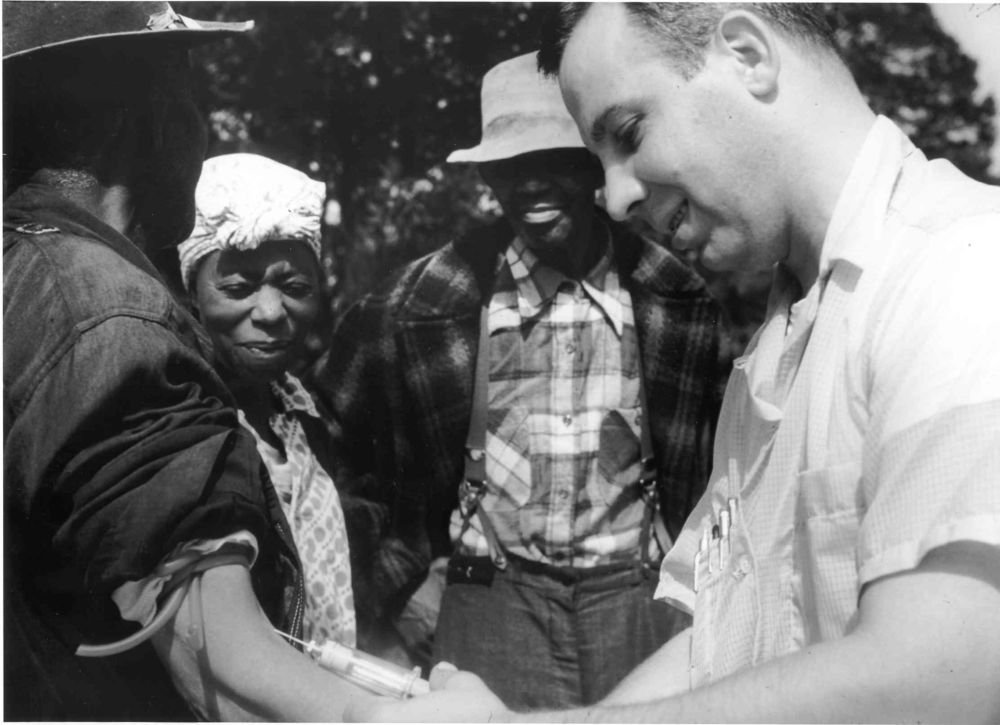The views expressed in this paper are those of the writer(s) and are not necessarily those of the ARJ Editor or Answers in Genesis.
Abstract
The history of the Tuskegee Syphilis Study is a salient example of the negative fruits of Darwinian racism. The almost half-century study compared the progression of syphilis in poor uneducated Black males with a control group of non-syphilis White subjects. Although effective treatment was available in the 1940s, it was withheld for the study purposes. The progression of syphilis was well known, and, as expected, many in the experimental group suffered from progressive paralysis, insanity, deafness, blindness, and other results from brain and central nervous system deteriorations. The study completed by the U.S. Public Health Service has, for good reasons, been compared to the Nazi medical experiments that occurred during World War II.
Keywords: Tuskegee Syphilis Study, Race, Blacks, Racism, Darwinism, Eugenics, Syphilis, Medical Experiments
Introduction
One of the most infamous results of Darwinian racism beliefs was the Tuskegee Syphilis Study completed in Macon County, Alabama, that began in 1932 and ended as recently as 1972. The 40-year-long study was conducted by the United States Public Health Service (PHS) and the Centers for Disease Control (CDC). The ostensible goal was to observe the natural history of untreated syphilis in Black males. All of the African-American men in the study were diagnosed with syphilis and were led to believe they were receiving free health care from the federal government.
The investigators obtained a sample of 600 impoverished, uneducated African-American sharecroppers from Macon County, Alabama. Included in the study were a total of 399 men, 25 years of age or older, all diagnosed with latent syphilis, and a control group of 201 men who were not infected (Jones 1993, 1) (fig. 1). Most of the men did not know they had syphilis because the signs and symptoms of primary and secondary syphilis are often mild, and thus not noticed or often ignored. However, the investigators medically determined that they all had syphilis, (which was a requirement to be involved in the study). During the latent stage, which lasts from a few weeks to over 30 years, no signs or symptoms of syphilis are normally evident. During this time, the disease parasites bore into the bone marrow, lymph glands, the vital organs, and especially the brain and central nervous system and begin late term syphilis (Jones 1993, 3).

Fig. 1. Doctor drawing blood from a patient as part of the Tuskegee Syphilis Study. https://en.wikipedia.org/wiki/Tuskegee_Syphilis_Study#/media/File:Tuskegee-syphilis-study_doctor-injecting-subject.jpg.
The result of late term syphilis includes a deterioration of the brain and central nervous system, causing progressive paralysis, insanity, even deafness and blindness. It is one of the most horrible diseases known to humanity, and to ignore even palliative treatment is inhumane. All of this was well known in the medical community when the study began in 1932. Yet when asked about the ethics of the experiment, the former director, Dr. John Heller, answered in 1972 that “There was nothing in the experiment that was unethical or unscientific” (Jones 1993, 8).
The research goal was to learn about the clinical differences between the Black and non-Black syphilitic males. The research model was a 1891 to 1910 Norway study that examined the records of nearly 2,000 untreated syphilitic White male patients at an Oslo clinic. A follow-up was published in 1929 (Jones 1993, 10). One major difference between the Norway study and the later Tuskegee study was that fully effective treatment for syphilis was available by the 1940s. Conversely, the Norway study produced clear results of the effects of the end results of syphilis. The American study focused on its progression in an “inferior race,” namely Blacks.
An incentive for participation in the study was the promise of free medical care and burial costs. The subjects were never informed of their diagnosis, but were told only that they had “bad blood.” They also were led to believe the program would last six months, but it ended up lasting 40 years. It was finally ended only when the study’s methodology and goal was exposed to the public. The infected men were not treated with penicillin even though it was widely available in the 1940s and was by then the standard treatment for this disease (Duff-Brown 2017). Before penicillin, Salvarsan (dioxy-diamino-arsenobenzol) was widely used to treat the disease. Scores of visits and numerous blood and other medical tests were completed on the experimental subjects. The reason was because syphilis is a systemic disease that requires many tests to properly evaluate.
When the research participants died, autopsies were completed to understand the long-term effects of syphilis in Blacks compared to non-Blacks. As expected, the results showed higher rates of morbidity and mortality among syphilitics compared to controls (Jones 1993, 2). Ironically, during slavery “Prescribing different remedies for blacks was the exception rather then [sic] the rule . . . slaves received the same treatment as their masters . . . the economic value of slaves made their health a matter of solicitous concern” (Jones 1993, 19).
In the end, the Tuskegee study was one of the worst abuses of Darwinian science in America (Gray 2002). Darwinian racism was openly a central part of the motivation to complete the study (Fredrickson 1971, 228–255). Scientists “discounted socioeconomic explanations of the state of Black health, arguing that better medical care could not alter the evolutionary” inferiority of the Black population (Brandt 1978, 293). It was widely held for much of the last century that Blacks were evolutionarily inferior because they were less-evolved than Whites. Consequently, improving diet or social conditions would be a waste of time. The Tuskegee Syphilis Study was an attempt to prove this racist belief, widely held by clinicians at the time and a focus in their medical education (Lombardo and Door 2006).
The Medical Consensus on Black Inferiority
The medical profession, with some notable exceptions, in the late nineteenth and early twentieth centuries supported the conclusions of Darwin which were amplified by many leading biologists, anthropologists, and ethnologists. One of the earliest professional groups to study the Negro in America was the medical profession:
[Their] conclusions, therefore, are a necessary adjunct to any analysis of American concepts of race and attitudes of racial inferiority. Racial attitudes, clothed in the authority of medical science, helped to suggest, justify, and dictate biological as well as social categories; indeed, medical science helped to explain and defend the prevailing social structure of early nineteenth-century America. (Haller 1972, 238)
Furthermore, evidence of bias was obvious in physician reports on the health effects of the post-Civil War emancipation of blacks. They concluded almost universally that “freedom had caused the mental, moral, and physical deterioration of the black population. They substantiated this argument by citing examples in the comparative anatomy of the black and white races” (Brandt 1997, 392). Moreover,
The social Darwinism of the post-Civil War period enabled traditionalists to reiterate their prejudices with the finality of scientific truth. Little changed in the controversy over female physicians besides the language of the debate. Scientific rationalism predominated by the 1880s, with evolution and eugenics mustered in defense of both sides. (Morantz- Sanchez 1997, 218)
Furthermore, Reverby, in her research of the history of “the infamous Syphilis Study,” concluded that the university contribution was very important. Many of the leaders of the U.S. Public Health Service that were involved in the Tuskegee Study:
went to medical school at a time when eugenic understandings of race were central to their education. Eugenics theory was used to explain hereditary differences in intelligence and disease, especially by race, and called for both increased breeding of the more intelligent and state-sponsored sterilization of the “unfit” . . . eugenicists believed in a hierarchy of races and that “bad blood” reflected a racialized ‘blood taint—a propensity toward moral and medical degeneracy.’ (Reverby 2009, 22)
Reflecting Darwinian ideas, W. T. English concluded that
A careful inspection reveals the body of the negro a mass of minor defects and imperfections from the crown of the head to the soles of the feet . . . . Cranial structures, wide nasal apertures, receding chins, projecting jaws, all typed the Negro as the lowest species in the Darwinian hierarchy. Interest in racial differences centered on the sexual nature of blacks. The Negro, doctors explained, possessed an excessive sexual desire, which threatened the very foundations of white society. (Brandt 1997, 392–393)
English estimated the “‘gray matter of the negro brain’ to be at least 1,000 years behind that of the white races, [but, in contrast,] his genital organs were overdeveloped” (Brandt 1997, 393). Another doctor, William Lee Howard, even blamed biology for what we now recognize as a socialization problem, namely the distorted view that the
attacks on defenseless white women are evidences of racial instincts that are about as amendable to ethical culture as is the inherent odor of the race . . . . When education will reduce the size of the negro’s penis as well as bring about the sensitiveness of the terminal fibers which exist in the Caucasian, then will it also be able to prevent the African’s birthright to sexual madness and excess. (Brandt 1997, 392)
Furthermore, medical studies of the Negro were also distorted by the Darwinian “eighteenth century’s hierarchical arrangement of the races of man” from the highest, the Caucasians, to the lowest, the Negro or, some Darwinist proponents argued, the Australian aborigine (Haller 1972, 238). As evidence of this physician, Samel A. Cartwright concluded that “the size of the Negro brain, . . . was about one-ninth less than the white brain, his facial angle was smaller, and the nerves supplying the abdominal and pelvic area were larger than in the white race” (Haller 1972, 248).
We know today how incorrect these claims are, and they were not accepted by every doctor at the time. One physician, writing anonymously in the Charleston Medical Journal and Review, claimed that the “distinctions that Cartwright found in blood, muscle, tendon, lymph, brain and nerves were ‘the fruit of the imaginative brain of some . . . . aspirant in the race for fame, rather than the actual demonstration of the scalpel’” (Haller 1972, 251). Darwin’s contribution in the motivation of the study was critical. Harvard professor Allan Brandt writes that a
review of the prevailing scientific thought regarding race and heredity in the early 20th century is fundamental for an understanding of the Tuskegee Study. By the turn of the century, Darwinism had provided a new rationale for American racism. Essentially primitive peoples, it was argued, could not be assimilated into a complex, white civilization. Scientists speculated that in the struggle for survival the Negro in America was doomed. Particularly prone to disease, vice, and crime, black Americans could not be helped by education or philanthropy. Social Darwinists analyzed census data to predict the virtual extinction of the Negro in the 20th century, for they believed the Negro race in America was in the throes of a degenerative evolutionary process. (Brandt 1997, 392)
Racism by Physicians
Racist views were also held by many trained physicians. As Jones observed, “Dr. Oliver Wendell Holmes opined that medicine “is as sensitive to outside influence, political, religious . . . . Few examples better illustrate this observation than the influence racial attitudes have exerted on the perception and response of white physicians to disease in blacks. Nineteenth-century physicians had ample opportunities to inject racial prejudice into their daily practices” (Jones 1993). Although much disagreement existed in medicine about many subjects, a “rare point of agreement . . . was that the health of blacks had to be considered separately from the health of whites” (Jones 1993, 16).
The Tuskegee Study Was Well Known in the Medical Field
As evidence that the Tuskegee Experiment was well known among doctors was the fact that the Tuskegee Study’s progress was regularly reported in medical journals and openly discussed in conferences at professional meetings. More than a dozen articles appeared in the nation’s leading “medical journals, describing the . . . study to a combined readership of over a hundred thousand physicians” (Jones 1993, 7).
Relatively few doctors spoke out against the Tuskegee study, supporting the conclusion that the medical community largely supported the “inferiority of Blacks” belief. This is also supported by the literature covered below. Actually, physicians’ “letters defending the study appeared in editorial pages across the country” (Jones 1993, 10). The influence of Darwinism was unabashedly open. For example:
Physician P. Tidyman drew a large proportion of his ideas from earlier anthropological writings showing that the black races differed fundamentally from the Caucasian in prognathous, bone system, skull dimension, and also internal bodily organs. Their nervous system . . . exhibited ‘less sensibility and irritability than is generally witnessed among whites’, a situation which was imperative in understanding subsequent treatment of the blacks. With the understanding that the black races were substantially different than the Caucasian in mental constitution, Tidyman believed that any investigation of diseases among the blacks would show the necessity for treating them quite differently from the Caucasian. (Haller 1972, 244)
Some doctors even believed that Negroes were a separate species from Caucasians, an idea called polygenism (Haller 1972, 252).
The movement against reliance on Darwinism was slow, but eventually an entirely new national attitude in medicine began to develop: “No longer was the scene dominated by . . . Herbert Spencer’s version of social Darwinism which made the patient responsible for his own folly when he chose his physician unwisely” (Hudson,1997, 205).
The Results of the Study
In the end, it became clear that the progress of syphilis was no different in Black men than in White men. The last stage, the tertiary stage, is present from 10 to 30 years after the initial infection. This stage does not occur for everyone infected with the disease, but results in severe medical problems affecting the nervous system, brain, blood vessels, heart, and other body organs. If untreated, the mortality rate is from 8% to 58%, depending on the health and nutritional status of the person. Although there is a greater death rate in males, few of the men in the study knew they had syphilis. It will never be known how many men infected with syphilis gave their sexual partners the disease, which could have killed many of them as well.
Finally, Outrage!
Once exposed, the outrage was so enormous that “not since the Nuremberg trials of Nazi scientists had the American people been confronted with a medical cause celebre” that, quoting a Philadelphia Inquirer editor, had “captured so many headlines and sparked so much discussion.” For many, it was a shocking revelation of the potential for scientific abuse in their own country: “That it has happened in this country in our time makes the tragedy more poignant” (Jones 1993, 11, emphasis in original). Alabama Senator John Sparkman denounced the medical experiment as “absolutely appalling” and “a disgrace to the American concept of justice and humanity.” One observer asked: “how in the name of God can we look others in the eye and say: ‘This is a decent country’” (Jones 1993, 11).
The involvement of the U.S. Public Health Service in the experiment was reminiscent of the behavior of Nazi Germany’s experiments carried out under the auspices of German universities and Josef Mengele and other Nazi doctors, most of whom were at least complicit with this evil (Bergman 2020):
[In the] Weimar Republic in the mid-twentieth century, more than half of all German physicians became early joiners of the Nazi Party, surpassing the party enrollments of all other professions. From early on, the German Medical Society played the most instrumental role in the Nazi medical program, beginning with the marginalization of Jewish physicians, proceeding to coerced “experimentation,” “euthanization,” and sterilization, and culminating in genocide via the medicalization of mass murder of Jews and others caricatured and demonized by Nazi ideology. (Haque et al. 2012, 473)
Furthermore,
Physicians were the most over-represented academic profession in the Third Reich. They participated in the Nazi programs of forced sterilization, systematic euthanasia, human experimentation, and mass genocide . . . . the German medical community [rapidly] became integrated into the Nazi state. (Cohen 1998, 336)
A common observation, as noted by one man referring to the Tuskegee Study, was that “Adolf Hitler allowed similar degradation of human dignity in inhumane medical experiments on humans living under the Third Reich” (Jones 1993, 12). Another commentator had difficulty believing that “such stomach-turning callousness could happen outside the wretched quackeries spawned by Nazi Germany” (Jones 1993, 12). Unfortunately, Darwin’s eugenic influence was rarely mentioned in most of these comments.
Attempts to Atone for the Study
The recent concern about racism in science has brought to light the injustice of the Tuskegee Study, motivating the “Howard Hughes Medical Institute’s six-figure donation is a step towards addressing racial injustice in the sciences” such as the Tuskegee Study (Witze 2020). A Nature article proclaimed: “Fighting Racism Demands More Than Just Words: Frustrated and exhausted by systemic bias in the science community, Black researchers call on their colleagues and institutions to take action” (Wright 2020). Furthermore:
[D]espite its lack of scientific rigor or reproducibility, this reliance on race as a biological concept persists in fields from genetics to medicine. The consequences of that reliance have ranged from justifications for school and housing segregation, to support for the Atlantic slave trade of the sixteenth to nineteenth centuries, genocidal policies against indigenous communities around the world, and the Holocaust. (Nelson 2019)
The Tuskegee study resulted in a 1974 out-of-court settlement of 10 million dollars which was divided into four categories:
- Living syphilitic group participants each received $37,500.
- Heirs of deceased syphilitic group participants each received $15,000.
- Living control group participants each received $16,000.
- Heirs of deceased control group participants each received $5,000. (U.S. Public Health Service).
Racism was for decades endemic in science because Darwinism depends on racial and other variations by which natural selection fuels evolutionary progress, and yet scientists claim to oppose racism (Comfort 2014). The current problem in science, as documented and cited by Comfort, is akin to the following:
Theodosius Dobzhansky, a brilliant population geneticist, was intellectually invested in the genetic concept of race, yet morally invested in anti-racism. “Dobzhansky’s paradox”, in Yudell’s phrase, was how to save biological race theory without sounding racist. He never did—and nor have we. (Comfort 2014)
The man who did the most to help destroy scientific racism in America was German-born Franz Boas (1858–1942), regarded as “the Father of American Anthropology.” He worked to disprove eugenic hereditarianism and Darwinian race science by his research in cultural anthropology:
Boas coined the word culture in its modern sense, and became perhaps the greatest opponent of the biological concept of race. He and his students studied human societies through an entirely cultural definition of human difference. Boas found, for example, that cranial characteristics that had been claimed to be innately racial were the result of differences in nutrition and overall health . . . . Boasian anthropology scientifically proved that race is not genetic. (Comfort 2014)
Summary
The influence of Darwinian racism in the Tuskegee Syphilis Study is well-documented and a powerful example of the harmful effects of the Darwinian worldview. Acceptance of the belief that all people alive today are descendants of one couple helps negate the view that some people groups are inferior to other people groups. The motive behind the study was fallacious, and the money and time could have been spent far better to study effective therapeutic interventions for syphilis. This could have improved the health of all males in all people groups. This is the inevitable conclusion of Acts 17:26, which says that God “made of one blood all nations of men for to dwell on all the face of the earth” (KJV). All human beings belong to one race: the human race (Ham and Ware 2019).
References
Bergman, Jerry. 2020. Darwinian Eugenics and The Holocaust: American Industrial Involvement. Ontario, Canada: Involgo Press.
Brandt, Allan M. 1978. “Racism and Research: The Case of the Tuskegee Syphilis Study.” The Hastings Center Report 8, no. 6 (December): 21–29
Brandt, Allan. 1997. “Racism and Research: The Case of the Tuskegee Syphilis Study.” In Sickness and Health in America: Readings in the History of Medicine and Public Health, edited by Judith Leavitt and Ronald Numbers, 392–404. Madison, Wisconsin: University of Wisconsin Press.
Cohen, Eyal. 1998. “The Nazification of German Physicians, 1918–1937.” Annals of the Royal College of Physicians and Surgeons of Canada 31, no. 7 (October): 336–340.
Comfort, Nathaniel. 2014. “Under the Skin.” Nature 513, no. 7518 (September 18): 306–307.
Duff-Brown, Beth. 2017. “The Shameful Legacy of Tuskegee Syphilis Study Still Impacts African-American Men Today.” Stanford Health Policy, January 6. https://healthpolicy.fsi.stanford.edu/news/researchers-and-students-run-pilot-project-oakland-test-whether-tuskegee-syphilis-trial-last.
Fredrickson, George. 1971. The Black Image in the White Mind: The Debate on Afro-American Character and Destiny, 1817–1914. New York, New York: Harper and Row.
Gray, Fred. D. 2002. The Tuskegee Syphilis Study: An Insiders’ Account of the Shocking Medical Experiment Conducted by Government Doctors Against African American Men. Montgomery, Alabama: NewSouth Books.
Haller, John. 1972. “The Negro and the Southern Physician: A Study of Medical and Racial Attitudes 1880–1860.” Medical History 16, no. 3 (June 30): 238–253.
Ham, Ken and A. Charles Ware. 2019. One Race One Blood: The Biblical Answer to Racism. Green Forest, Arkansas: Master Books.
Haque, Omar, Julian De Freitas, Ivana Viani, Bradley Niederschulte, and Harold J. Bursztajn. 2012. “Why Did So Many German Doctors Join the Nazi Party Early?” International Journal of Law and Psychiatry 35, no. 5–6 (September–December): 473–479.
Hudson, Robert P. 1997. “Abraham Flexner in Perspective.” In Sickness and Health in America: Readings in the History of Medicine and Public Health, edited by Judith Walzer Leavitt and Ronald L. Numbers, 200–210. Madison, Wisconsin: University of Wisconsin Press.
Jones, James. 1993. Bad Blood: The Tuskegee Syphilis Experiment. New York, New York: Free Press.
Lombardo, Paul A. and Gregory M. Door. 2006. “Eugenics, Medical Education, and the Public Health Service: Another Perspective on the Tuskegee Syphilis Experiment.” Bulletin of the History of Medicine 80, no. 2 (Summer): 291–316.
Morantz-Sanchez, Regina. 1997. “The Connecting Link: The Case for the Woman Doctor in 19th-Century America.” In Sickness and Health in America: Readings in the History of Medicine and Public Health, edited by Judith Walzer Leavitt and Ronald L. Numbers, 213–224. Madison, Wisconsin: University of Wisconsin Press.
Nelson, Robin. 2019. “Racism in Science: The Taint That Lingers.” Nature 570, no. 7762 (June 25): 440–441.
Reverby, Susan. 2009. Examining Tuskegee. The Infamous Syphilis Study and Its Legacy. Chapel Hill, North Carolina: University of North Carolina Press.
U.S. Public Health Service. https://www.cdc.gov/tuskegee/faq.htm.
Witze, Alexandra. 2020. “Wealthy Funder Pays Reparations for Use of HeLa Cells.” Nature 587, no. 587 (October 29): 20–21.
Wright, Vashan. 2020. “Fighting Racism Demands More Than Just Words.” Nature 583, (July 9): 319–322. https://media.nature.com/original/magazine-assets/d41586-020-01883-8/d41586-020-01883-8.pdf.











